The Upper Echelons of Medieval and Early Modern Europe
Pre-modern Europe was very hierarchical, based on birth and wealth, with those born into the aristocracy and royal families having the income to support doing anything other than being peasant farmers (which most of Europe was), including being patrons of the arts and sciences and having involvement in politics.
French Royalty
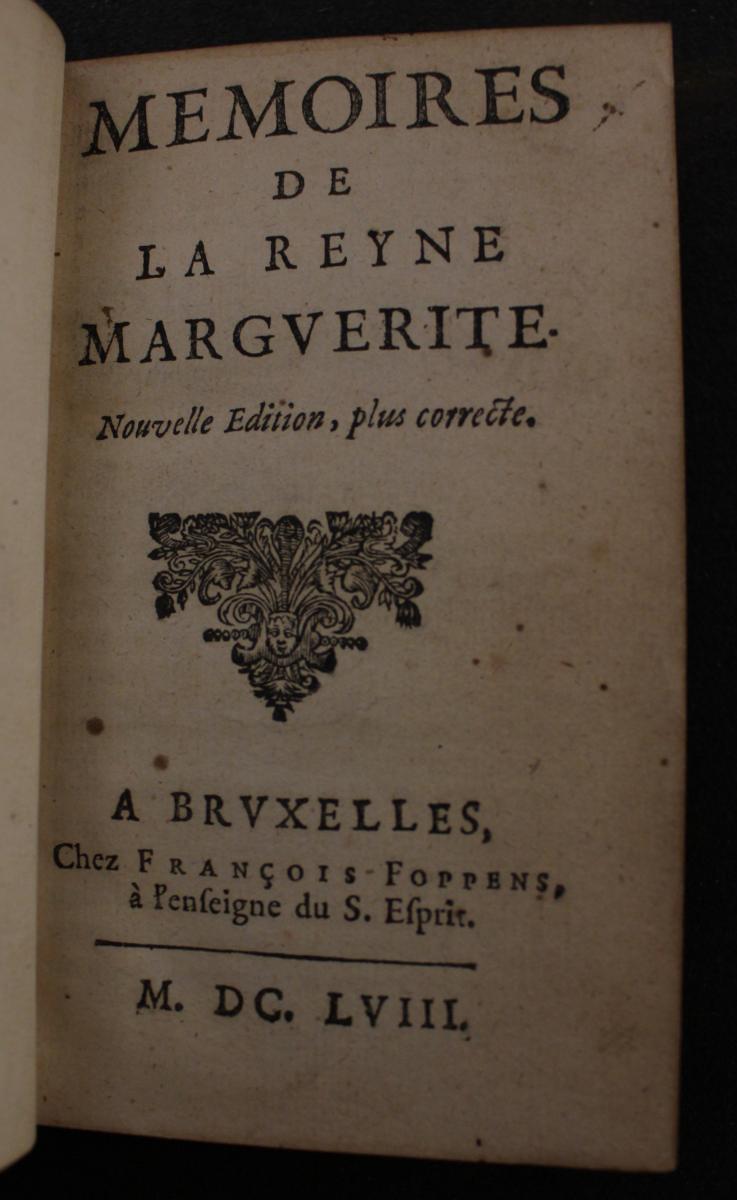
Queen Marguerite, consort of Henry IV, King of France (1553-1615)
Memoires de la Reyne Marguerite
Bruxelles : Chez François Foppens, 1658
Description: These are the memoirs of Marguerite de Valois (1553-1615), daughter of King Henri II and Queen Catherine de Médicis, and wife of King Henri IV of France. The memoirs include her reflections on her religion (and the correctness of Catholicism), her marriage, the St. Bartholomew’s Day Massacre, the various visits she gave and received, her views of motherhood, and her interactions with her husband’s lovers, among other things. These memoirs show the interpretations of such a significant event like the St. Bartholomew’s Day Massacre by an actor directly involved in the event. They also give a glimpse into the more mundane aspects of court life, and Marguerite’s desire to emphasize her unwavering Catholicism regardless of her husband’s Huguenot background. This French text was published in 1658 as a “more correct new edition.” The original French edition was published in 1628, although both were published posthumously. The book is divided into 21 Livres, has gilt edged pages, and can fit into the palm of one’s hand. -- Kathleen Kokensparger
Adoption Price: $50
ADOPTED!
English Royalty: medieval
Sir Robert Cotton (1571-1631)
A short view of the long life and reign of Henry III, king of England, presented to King James
[London] Printed, 1627
Adoption Price: $50
William Prynne (1600-1669)
The history of King John, King Henry III. and the most illustrious King Edward the I. wherein the ancient sovereign dominion of the kings of England, Scotland, France, and Ireland, over all persons in all causes, is asserted and vindicated, against all encroachments, and innovations whatsoever. The mistakes in some printed statutes, cannonists, law-books, histories, &c. and other matters of moment, are rectified, and rescued from oblivion. Collected out of the ancient records in the Tower of London: and now published for the better advancement of learning. By William Prynne. And finished a little before his death
London, Printed by Thomas Ratcliff, and Thomas Daniel, for Philip Chetwind, Nathaniel Brook, and Edward Thomas, 1670
Description: 46 p. ℓ., 96 p., 97-133 (i.e. 134) numb. ℓ., 117-1307, [1] p. 35 cm; Signatures: A4, a-k4, l2, A-Y4, R-Z4, Aa-Za4, Aaa-Zzz4, Aaaa-Zzzz4, 5A-5Z4, 6A-6Z4, 7A-7Z4, 8A-8C4, 8D2; Irregularities in paging; leaf 107 repeated in numbering; Third volume of the work commonly referred to as "Prynne's records". William Prynne was a lawyer and author most known for his over 200 books and pamphlets. Prynne attended Oriel College, Oxford. He was very involved in the discussion of religion in England in the 1600’s as a Puritan. He was against stage-plays in which his work Histriomastix was on. He was once pilloried and branded on the cheeks with an S. L. and imprisoned for a time for his attacks against authorities. He rose and fell from grace throughout his career depending upon the controlling faction of England. This work represents his collection of records when we became Keeper of Records at the Tower of London. The history of King John, King Henry III. and the most illustrious King Edward the I is not so much a chronicle as a collection of different sources available from each king. Most of the book is in Latin with brief commentary following. Prynne anti-papist views can be seen by the title throughout the work of the “Popes intolerable usurpation upon the English.” The wealth of information in this volume is incredible. The title page includes a signature of a previous owner. The book itself is gorgeous, being leather bound with metal corner pieces and having metal clasps to hold the book shut. -- Dylan Powell
Adoption Price: $25
Alexander Bicknell (d.1796)
The life of Alfred the Great, king of the Anglo-Saxons.
London, Printed for J. Bew, (1777)
Description: The Life of Alfred the Great was published in 1777 as a historical text detailing the life of Alfred the Great, a man remembered in English history as one of the greatest kings to rule England. This historical text was created by Alexander Bicknell, a struggling Englishman living in the later half of the 1700s. While he published numerous historical works during his life, few were met with any praise. This particular text was important because it was written during a time of revolution in the American colonies. The reason for this text could possibly have been to remind the British people what kind of great leaders they came from. Alfred was and still is seen as one of the greatest kings of Britain ever to live. Although he was a medieval king, many of his ideas were greatly influential in how the country was being run during the modern period. During his reign he also had to deal with the Danish invasions which could have been seen as a parallel to the American revolution in 1776.
There is very little information known about Bicknell other than that he died in 1786 and his written works were not received well. For this particular book there is a great illustration of Alfred in the beginning and a penciled in notation about the author’s name on the title page. This notation could have been a more recent addition, but there is no way to tell; the penciled in part writes out Alexander where there was originally only printed an “A.” There is also an interesting in part the introduction where Bicknell makes clear that his intention for writing this book was to offer a history of Alfred for the public to read. This means his text was simple and well put together to show the emphasis placed on Alfred by the English people. During the time Bicknell was writing this historical text, there was a great deal of political unrest in England. While it is probable that Bicknell wrote this work simply as a historical text for educational purposes, he could have written it as a reflection back to a time of great leadership for England. This would have placed more emphasis on Bicknell’s introduction where he stated that this book would be for the public to read.
While Bicknell did not leave a lasting impact on the world of English literature, his histories are important. The Life of Alfred the Great would have been a very important book for people who were looking back on the great leaders of England during a time of strife and civil war. This small book has large print and is written in old English, but is meant to be read as a history textbook and is still today informative on King Alfred. There is a picture of Alfred at the start of the book, and a penciled notation about the author's name. -- Lindsey Peterson
Adoption Price: $50
George Vertue (1684-1756)
The heads of the kings of England : proper for Mr. Rapin's History, viz. Egbert ... Alfred ... Canute ... William ... and all the succeeding kings and sovereign queens, to the Revolution : with some of the most illustrious princes of the royal family / collected, drawn, and engraven ... by George Vertue; to which are added, the heads of Mr. Rapin and N. Tindal, M. A. and an account of the several heads, of the antiquities that have been followed, and of the pictures copied for engraving them; also twenty two plates of the monuments of the songs of England
London: Printed for James, John and Paul Knapton ..., 1736
Description: This impressive folio was originally created by George Vertue (1684-1756), an English engraver and antiquary. The additional plates that are included were engraved by G. Kneller between 1744 and 1746, including about twelve heads. It was printed by James, John, and Paul Knapton in 1736 in London. It includes the majority of crowned kings and queens of England depicted in portrait fashion, many of the portraits being based on famous or ubiquitous images of the monarchs. Interestingly, there are three monarchs included before the conquest, Ecbert, Cnut, and Alfred the Great, as well as some rulers that were not actually kings, such as the Duke of Bedford, regent for Henry VI in France. This is interesting particularly in that Empress Matilda was not included, and arguably had more reason to be than the Duke. The imagery included around the engraved portraits can bear particularly striking or fascinating imagery. Richard III’s portrait is depicted above a boar (his symbol) being devoured by a dragon (the symbol of Henry VII). Further, Henry VII is the only monarch depicted with a portrait of his consort, Elizabeth of York, included, making a striking visual representation of their relationship. Following the portraits are illustrated engravings of several important funeral monuments as well as coins and medals associated with the more contemporary monarchs. -- Danielle Alesi
Adoption Price: $50
ADOPTED!
Mary Ann Hookam
The life and times of Margaret of Anjou, queen of England and France; and of her father René "the Good", king of Sicily, Naples, and Jerusalem. With memoirs of the houses of Anjou.
London, Tinsley Brothers, 1872
Description: This is the second volume of Mary Ann Hookham’s “The Life and Times of Margaret of Anjou, Queen of England and France,” published in London for the Tinsley Brothers in 1872. Its full time is The Life and Times of Margaret of Anjou, Queen of England and France; and of her Father Rene “The Good,” King of Sicily, Naples, and Jerusalem with Memoirs of the Houses of Anjou. Although Hookham provides a look at Henry VI’s queen consort, Margaret of Anjou, that is more tragic and sympathetic than has been typically been provided, especially in the chronicles and William Shakespeare’s history plays, she still includes Shakespearean quotes at the beginning of each chapter. This volume centers on Margaret’s life from 1455 until her death in 1482. While the first volume discusses Margaret in relation to her father, family, upbringing, and early life in England, it is this volume that depicts the parts of her life she is most remembered for: her role as the head of the Lancastrian cause in the Wars of the Roses. Furthermore, many traditional depictions of Margaret’s life end with the death of her husband and son, the moment she ceases to have any power, this depiction instead provides a lengthy discussion of her widowhood spent in England, her ransom to France, and tragic death. This particular volume also has a beautiful front piece illustration of Margaret, an enigmatic, formidable, and tragic queen. -- Danielle Alesi
Adoption Price: $25
ADOPTED!
English Royalty: Tudors
anonymous
The history of the most renowned Queen Elizabeth, and her great favourite, the Earl of Essex. In two parts. A romance
London: printed by W.O., [1650?]
Description: The History of the Most Renowned Queen Elizabeth, and Her Great Favourite, the Earl of Essex. In Two Parts. A Romance was written by an anonymous author in 1650. The book in the University of Nebraska-Lincoln Special Collections department is the first edition of the text, is in its original binding, and is very rare. After 1650 the book underwent several reprintings and was translated into other languages such as German and French throughout the late seventeenth and into the eighteenth century. This document tells the exaggerated story relating to the relationship between Queen Elizabeth I and her “favorite,” Robert Devereux, the Earl of Essex, and subsequently the queen’s despair over the earl’s eventual treason and execution. On the last page, there is an exquisite representation of Queen Elizabeth. At only 24 pages long, this chapbook is a very quick and enjoyable read. -- Maureen Owens
Adoption Price: $50
ADOPTED!
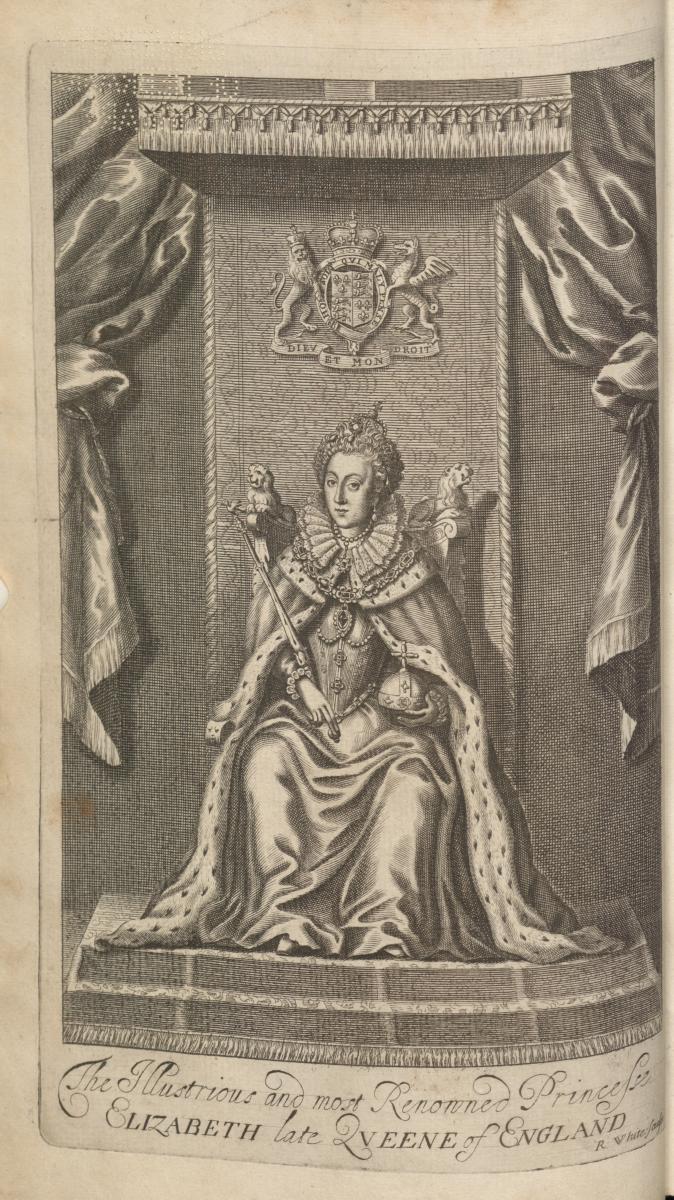
William Camden (1551-1623)
The history of the most renowned and victorious Princess Elizabeth, late Queen of England
Uniform title: Annales rerum Anglicarum et Hibernicarum regnante Elizabetha
London: Printed by E. Flesher, for C. Harper and J. Amery, 1675
Adoption Price: $100
ADOPTED!
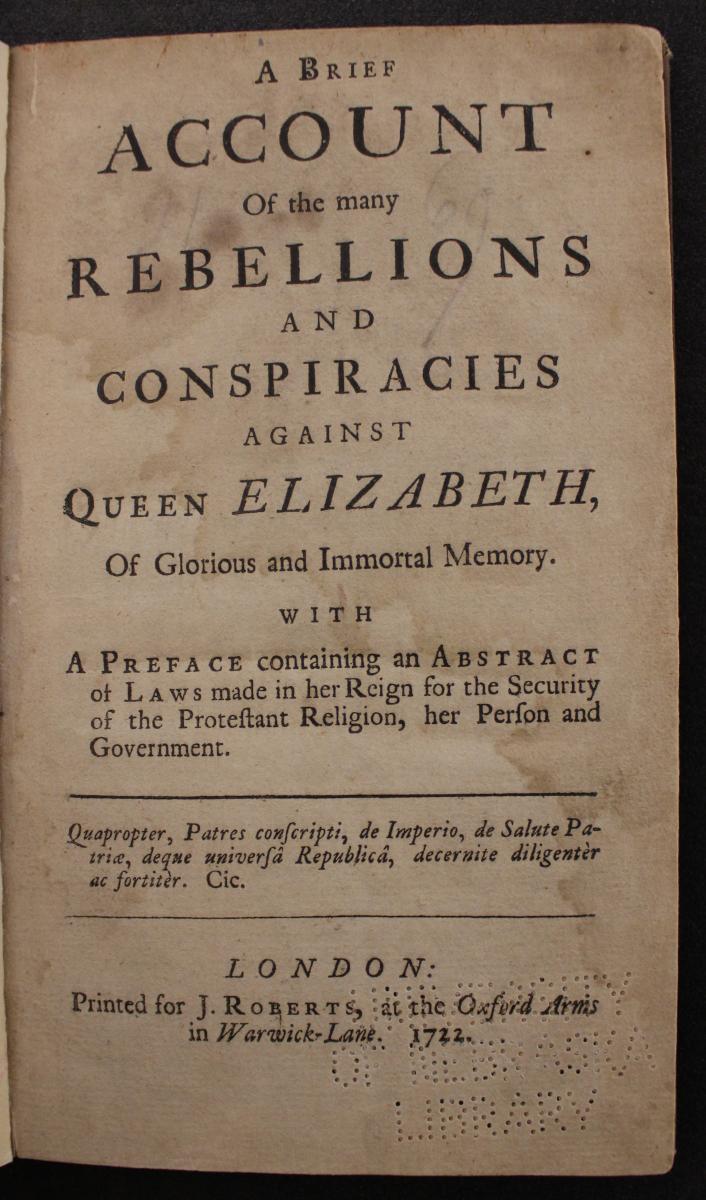
William Camden (1551-1623)
Britannia. Selections. A Brief account of the many rebellions and conspiracies against Queen Elizabeth of glorious and immortal memory : with a preface containing an abstract of laws made in her reign for the security of the protestant religion, her person and government
London : Printed for J. Roberts ..., 1722
Description: The Brief Account of the Many Rebellions and Conspiracies Against Queen Elizabeth of Glorious and Immortal Memory was published in 1722. The work 50 pages long and is selections from William Camden’s Annales. The text focuses on the rebellions which occurred during the reign of Queen Elizabeth between 1558 and 1603. The Preface includes a list of the laws passed during that time which related to Protestantism, protection of the queen, and the security of the government. The rest of the book looks at a variety of conspiracies including the Babington Plot involving Mary Stuart, Elizabeth’s cousin and former Queen of Scotland, and the plot and rebellion of the Earl of Essex, a former favorite of Queen Elizabeth’s; both individuals were beheaded for their involvement in treasonous plots. The author of the book, William Camden, was an English antiquarian and historian. Camden lived from 1551 to 1623 and published several notable works including Britannia, a topographical and historical survey of Great Britain and Ireland, and the Annales, which was a two-volume history about the reign of Queen Elizabeth I. -- Maureen Owens
Adoption Price: $100
ADOPTED!
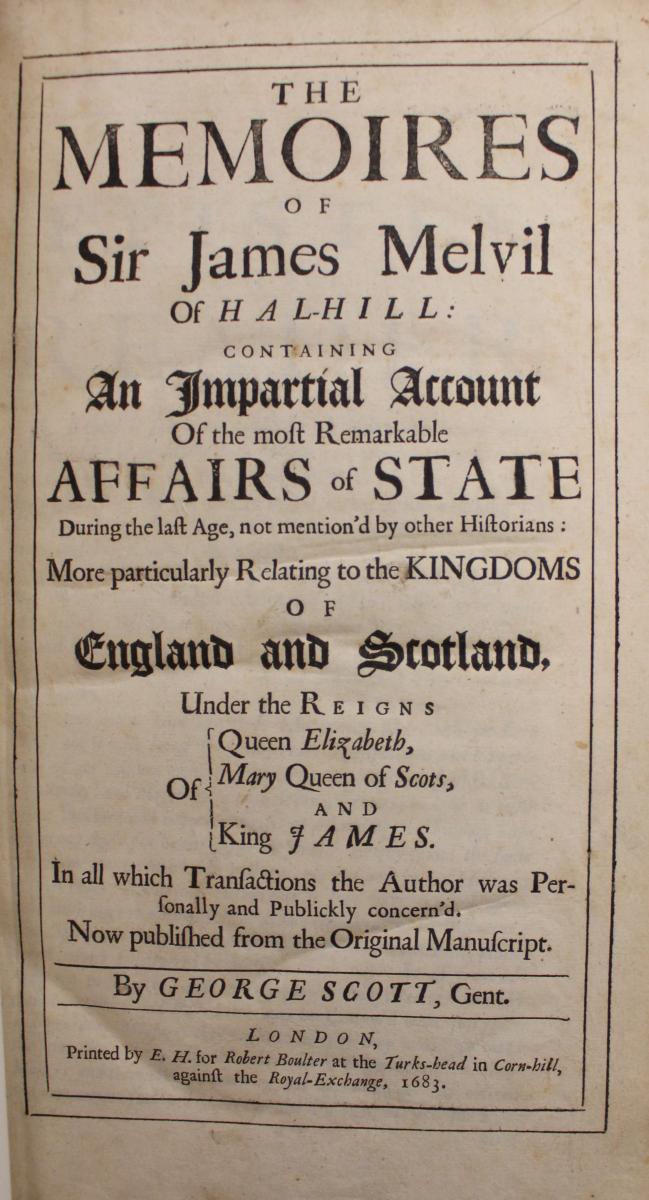
Sir James Melville (1535-1617)
The memoirs of Sir James Melville of Hal-hill: : containing an impartial account of the most remarkable affairs of state during the last age, not mention'd by other historians: more particularly relating to the Kingdoms of England and Scotland, under the reigns of Queen Elizabeth, Mary Queen of Scots, and King James. In all which transactions the author was personally and publicly concerned. / Now published from the original manuscript. By George Scott, Gent.
London, : Printed by E.H. for Robert Boulter ..., 1683
Description:Sir James Melville of Halhill (1535-1617) was a Scottish diplomat and memoirist who worked with both Mary, Queen of Scots and James VI. When James took the throne after his mother, Mary’s, forced abdication, Melville worked with James at the Scottish court, and was appointed to serve Queen Anna after her marriage to James in 1589. He was invited to accompany James to England in 1603, but Melville preferred to stay in Scotland, and did so until his death. This volume contains his memoirs from his time serving the Queen and King of Scotland and contains his observations of his work, from his mission to help lessen Queen Elizabeth’s distaste at Mary’s marriage to Henry Stuart and his work on the Scottish witch trials in 1592. This particular edition was published in 1683 by E. H. for Robert Boulter at the Turks Hand in Corn-hills against the Royal Exchange, and was edited by George Scott. Robert Boulter was a bookseller in London, and was one of the first three publishers of the first edition of Paradise Lost in 1667. -- Courtney Herber
Adoption Price: $100
ADOPTED!
Paul Hetzner (1558-1623)
Paul Hentzner's travels in England, during the reign of Queen Elizabeth, translated by Horace, late earl of Oxford, and first printed by him at Strawberry Hill: to which is now added, Sir Robert Naunton's Fragmenta regalia; or Observations on Queen Elizabeth's times and favourites; with portraits and views
London, Printed for E. Jeffery, 1797
Description: Paul Hentzner’s Travels in England is a very interesting tale about Hentzner’s travels through England and what he experienced while travelling. This was a very important text at the time it was originally written because it gave extensive insight into the normal life of English citizens as well as information about Elizabeth herself. Hentzner was a German lawyer who lived between 1558 and 1623 and travelled through England during Elizabeth’s reign. During his travels he recorded specifically details about Elizabeth, including information about those individuals who were important to her government and her person. In this particular book there are numerous illustrations of some of these individuals with color for their faces even. This book was not published till well after Hentzner’s death by Sir Robert Naunton who had it as part of his book Fragmenta Regalia. When Travels in England was published in the later 1700s it was most likely a part of a revival in Elizabethan works to remember the great queen. Following the death of Elizabeth there were numerous cults that surrounded her memory. Throughout the years there were increases and decreases in these particular cults, it is possible this particular work was published during this revival. This book also includes The life and death of the merry deuill of Edmonton, a depiction of Windsor castle, Thomas Wolsey, and has numerous blank pages at the end of the bound volume.
In this book there are numerous illustrations, including a great picture of Elizabeth in the very beginning. Most of the illustrations are to show the individual people who Hentzner was describing in his text. These illustrations are now very important because there are detailed pictures of people from Elizabeth’s time that we now can know what they looked like. While this book is informative and made to be read as an early modern historical text, it is written as a diary. Hentzner describes his journey as he is having it and makes the reader feel as if they are in his position visiting England during the late 1500s. The amount of text varies greatly throughout the book and more detail is given to certain points of interest. One point is particular interest in Elizabeth, as the title insinuates, and because of this work there is a greater depth of knowledge able to be added to the historical knowledge about her reign. -- Lindsey Peterson
Adoption Price: $25
ADOPTED!
Society of Antiquaries of London Jousts at Westminster the 12 of February by the King, my Lord of Devon, Sr. Tho. Knyvet and Edw. Nevill, Ao. Io. H. VIII
A description of the solemn jousts held at Westminster the 13th day of February in the first year of King Henry ye VIII, in honor of his Queen Katherine upon the birth of their eldest son Prince Henry, A.D. 1510, taken from the Original Roll now in the College of Arms, London. Pictorial representations of participants and entourage attending the joust, based upon the descriptions in Edward Hall's Chronicle, and the first volume of Raphael Holinshed's Chronicles of England
[London] : Sumptibus Soc. Antiquariæ Lond., A.D. 1726
Description: This book is a truly incredible pictorial description of the jousts held at Westminster on February 13, 1510 by King Henry VIII in honor of his wife Queen Katharine of Aragon and the birth of their first son Henry. The pictures in the book are compiled from the roll taken from the College of Arms in London. It depicts the representations of the participants in the celebrations based on the descriptions provided in Edward Hall and Raphael Holinshed’s historical chronicles of England. This particularly book was compiled and published in 1726. Contextually important, this joust represents a time in Henry VIII’s reign where he was hopeful for his future heirs with Katherine of Aragon. Their son Henry, for whom these jousts were conducted, died in only a few short weeks, as would all of their children save one daughter, the future Mary I. It was the successive infant deaths and miscarriages that eventually led Henry VIII to break from the Catholic Church of Rome and declare himself head of the English church in order to secure an annulment of his marriage to Katherine and remarry.
A particularly important and striking aspect of this work is that one of figures of the ceremonies that appears twice is a man named John Blanke, a trumpeter for in Henry VIII’s retinue and a black musician known to be living in London and paid for his services. Blanke is one of the very first recorded people of color in Tudor England and though little is known about his life, his presence in the royal court and this book is an exciting hint at the potential research in the multicultural aspects of early modern and renaissance England.-- Danielle Alesi
Adoption Price: $50
ADOPTED!
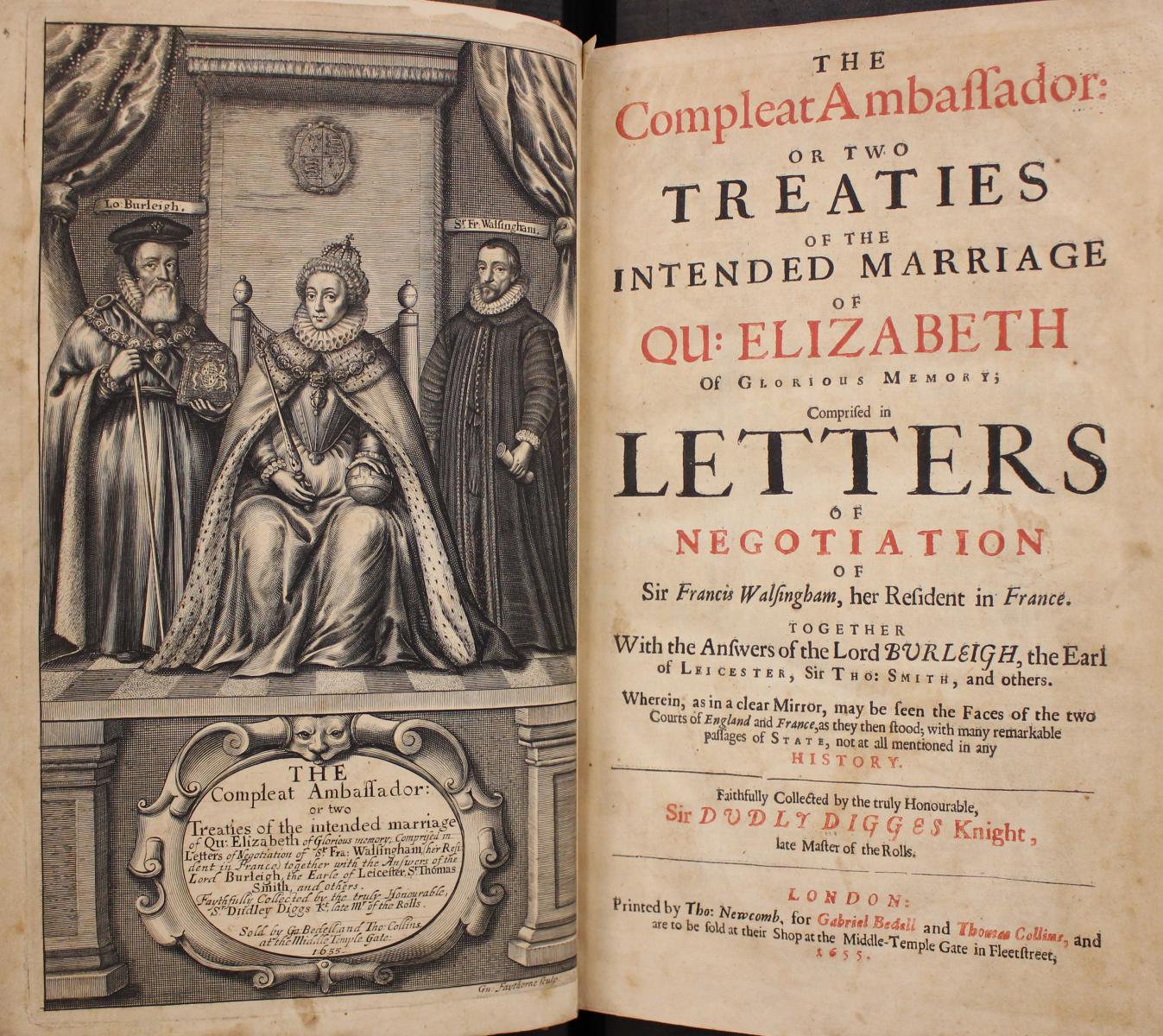
Sir Dudley Digges (1583-1639), edited by Sir Francis Walsingham (1530?-1590)
The Complete Ambassador: or, Two treaties of the intended marriage of Queen Elizabeth of glorious memory; comprised in letters of negotiation of Sir Francis Walsingham, her resident in France. Together with the answers of the Lord Burleigh, the Earl of Leicester, Sir Tho: Smith, and others. Wherein, as in a clear mirror, may be seen the faces of the two courts of England and France, as they then stood; with many remarkable passages of state, not at all mentioned in any history. Faithfully collected by the truly Honourable, Sir Dudly Digges, knight
London, Printed by T. Newcomb, for G. Bedell and T. Collins, 1655
Description: The Complete Ambassador is a large folio written by Sir Dudley Digges and printed in the year 1655. This folio contains numerous letters between Elizabeth I, Sir Francis Walsingham, Lord Burghley, and many others who were corresponding about the potential marriage of Elizabeth to a French Duke. The reason all of these individuals were in correspondence was because the period of time which these letters date to was a crucial moment in Elizabeth’s history and England’s history. Sir Francis Walsingham is particularly important in this text because he, at the time, was the English ambassador in France. While he was ambassador he worked tirelessly to propose a marriage between Elizabeth and a French duke. Fortunately for England, the match was never made because Elizabeth herself did not want to pick one of the dukes proposed to her by Walsingham. The Complete Ambassador is extremely important because it not only contains all of the letters of correspondence at this time, but it also has letters to individuals, usually Walsingham, by Elizabeth herself. The combining of these letters into one folio allows the reader to get a deeper understanding of Elizabeth herself and the importance she placed on her place as ruler of her country.
The letters contained in this text date within a decade between 1570 and 1580. This was also a crucial moment in history because of the St. Bartholomew’s Day massacre which took place in Paris, France in 1572. The inhumane slaughter of thousands of Protestants by Catholics drew much attention to the potential marriage of Elizabeth to a Catholic French Duke. Because England was a Protestant country, Elizabeth chose her refusals of marriage carefully so as not to offend any French and start a war. Luckily, Protestantism was able to prosper in England and Elizabeth never chose to marry anyone, giving her the title of Virgin Queen.
This particular folio was published in 1655 by Sir Dudley Digges, an Englishman who sat in the House of Commons between the years of 1610 and 1629. During his life he also spent a great deal of time and money investing in expeditions to the new world and his name has been given to a few islands and one cape near the Hudson Bay in Canada. During his time working for England and after he was knighted by James I in 1607, he later became Master of the Rolls in 1638. While this position made him an important man, he was also given access to the records of the Court of Chancery. With his new role he would have had access to the letters passed between Elizabeth and her men during the 1570s, thus giving him the material he needed to put together this folio. This folio would have been particularly important at this time because of the turmoil which would have come out of the execution of Charles I in 1649, shortly after Digges had died in 1639. This folio would have represented Elizabeth’s Protestant devotion to the people of England and would have been a hallmark of her golden reign. It still continues to represent her devotion to her country to this day. This folio also contains an exceptional illustration of Elizabeth, Walsingham, and Lord Burghley on the front page. -- Lindsey Peterson
Adoption Price: $100
ADOPTED!
Queen Mary Stuart of Scotland and the Stuart Dynasty
King Charles I of England (1600-1649)
Reliquiae sacræ Carolinæ: Or The works of that great monarch and glorious martyr King Charles I : Collected together, and digested in order, according to their several subjects, civil and sacred
Hague [i.e. London] : Printed by Samuel Browne [i.e. Francis Leach for Richard Royston], 1651
Description:Collected and published in 1651 in The Hague by Samuell Browne, this volume contains the collected works of King Charles I of England (r. 1625-1649). Within this collection are his works, both Civil and Sacred, and includes texts of Charles’ speeches and messages for peace, the Eikon Basilike, texts of his prayers just before his execution, among others. King Charles I was a well-educated and articulate monarch, and his speeches and letters are apt demonstrations of his rhetorical skills. Particularly interesting are his letters to his wife, Queen Henrietta Maria, and to his children, after his capture in the Wars of the Three Kingdoms, because they help to not only put the King on the page, but also to humanize a principled man who was steadfast in his beliefs, and who clearly loved his wife and children. This is not the only book that Samuel Browne published, but it was one of his best sellers, and the fact that it was published in the Netherlands is not surprising, especially when one considers the political climate in England in 1651. At the time of publication, England was ruled by Oliver Cromwell, who had been leader of the party in Parliament which called and signed for Charles’ death. Samuel Browne had worked in London before the Wars of the Three Kingdoms broke out and was a staunch royalist. When war broke out, he fled to the Continent and published in support of his king. After the restoration of Charles II to the English throne, Browne returned to England, but died shortly after in a 1665 outbreak of plague.
In this particular volume, there are several reader’s marks throughout, one on the main title page, where it looks like something had been written but then crossed out, making whatever handwritten text there had been entirely illegible. There are also horizontal lines have been hand-written into the text which have been presumably used to more easily differentiate between the letters, speeches, etc. There is also a sticker in the front cover of the book which shows that this volume was once in the collection of Charles N. Dietz, a wealthy lumber magnate in the late nineteenth century, of Omaha. Dietz was the first student ever enrolled at Iowa Agricultural College, or what is now known as Iowa State University. -- Courtney Herber
Adoption Price: $100
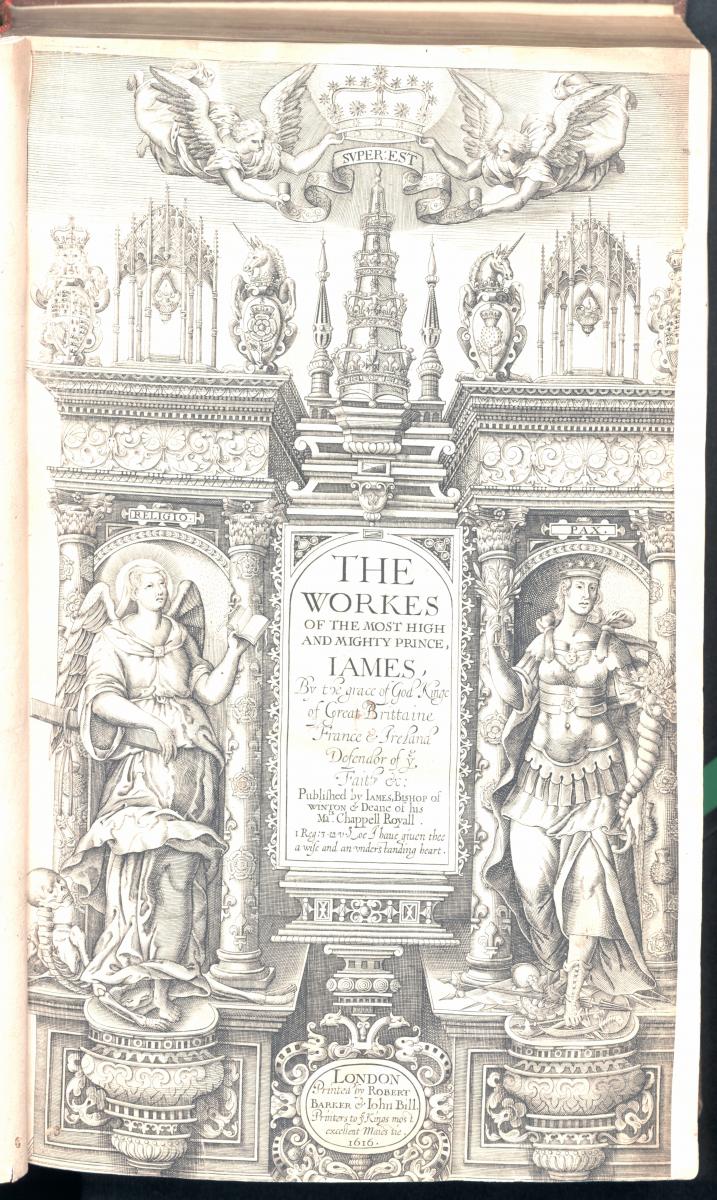
King James I of England (1566-1625)
The works of the most high and mighty prince, James, by the grace of God, King of Great Britain, France and Ireland, defender of the faith, &c.
London : Printed by Robert Barker and John Bill, printers to the Kings Most Excellent Majesty, 1616
Description: Description: [42], 569, [3] p. : .ill., coat of arms, ports. ; 35 cm. (fol.) Signatures: pi²a-e⁴(-e3)A-3A⁶3B⁴ ; added engraved title page, with architectural border; engraved frontispiece (portrait of James I) on verso of half title leaf Printer's device on t.p.; initials (some historiated); head- and tail-pieces. James the VI and I was first king of Scotland and after Queen Elizabeth I’s death became king of England and Ireland as well. James had many scholarly endeavors during his reign and this book contains most of them in one place, published in 1616. There are a variety of subjects included. It is dedicated to his son Prince Charles with a portrait included. The collection includes, The Two Meditations (on biblical scripture), Daemonologie, Basilicon Doron, The Trew Law of Free Monarchies, A Counter-blast to Tobacco, A Discourse of the Powder Treason, An Apologie for the Oath of Allegiance, A Praemonition to all Christian Monarches, A Defence of the Right of Kings, and five speeches from Parliament. This book is not in the original binding but has handwritten notes especially in the section of the Law of Free Monarchies and the speeches. It includes a large illustration of James’ coat of arms as well as a portrait. There are also sonnets by the king scattered throughout the book in Latin as well as English. The title of Basilicon Doron is printed in Greek and dedicated to his son Henry. The work Daemonologie, is a discussion on magic and witchcraft, one of James’ fascinations. Most of the other works are ideas on monarchy based on theology. There are also confessions of the people involved in the Gunpowder plot, including the declaration of Guy Fawkes. -- Dylan Powell
Adoption Price: $100
Sir William Sanderson (1586?-1676)
A Complete History of the lives and reigns of Mary queen of Scotland, and of her son and successor, James VI, king of Scotland; and (after Queen Elizabeth) king of Great Britain, France, and Ireland, the First ... Reconciling several opinions, in testimony of her, and confuting others, in vindication of him, against two scandalous authors: 1. The court and character of King James. 2. The history of Great Britain ... Faithfully performed, by William Sanderson, esq.
London, Printed for H. Moseley [etc.] 1656
Adoption Price: $50
ADOPTED!
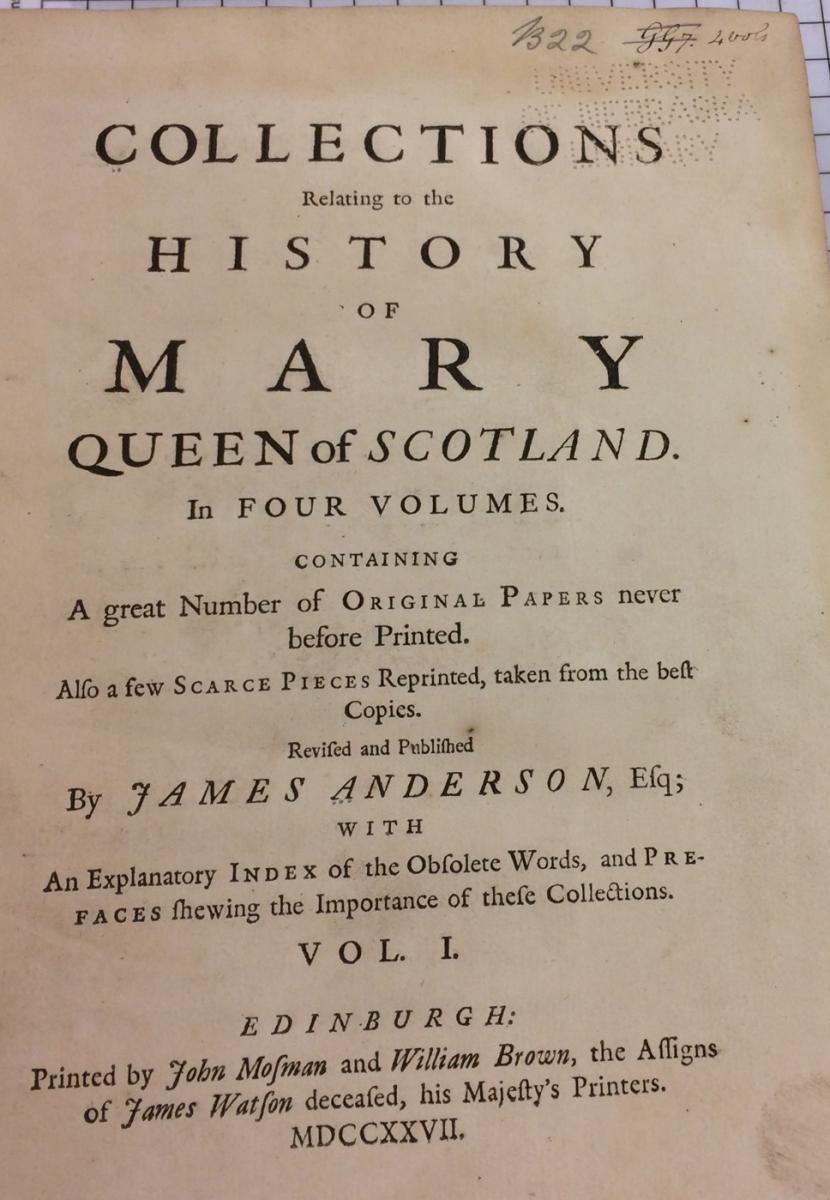
James Anderson (1662-1728)
Collections relating to the history of Mary, queen of Scotland. Containing a great number of original papers never before printed. Also a few scarce pieces reprinted, taken from the best copies. Rev. and pub. by James Anderson
Edinburgh, Printed by J. Mosman and W. Brown, 1727-28
Description: This four volume work collects a tremendous history of Mary, Queen of Scots. Published almost 200 years after her death, this collection is perhaps not comprehensive, but still very significant in its scope. Historiographer James Anderson, who compiled this thorough collection, was careful to include works by Mary’s detractors as well as her defenders. Anderson’s study of the law led to his interest in the collected papers which would become his history of Mary, Queen of Scots, among other works. Despite relative fame after publishing his essay “Historical Essay Shewing that the Crown and Kingdom of Scotland is Imperial and Independent,” Anderson spent much of his life in poverty. He is known for his use of primary documents to support the positions he argued. This collection encompasses four volumes, the last of which is in two parts. The papers collected here include proclamations, letters, acts, bonds, and lists, as well as Buchanan’s “Detection of the Doings of Mary Queen of Scots.” All of the volumes have their original binding and are in remarkable condition for their age. -- Sarah Walcott For more information, see the Oxford Dictionary of National Biography entry for James Anderson.
Note: four volumes
Adoption Price: $50, each volume
Abel Boyer (1667-1729)
The History of Queen Anne. Wherein all the civil and military transactions of that memorable reign are impartially related. The whole intermixed with several authentic and remarkable papers; together with all the important debates in Parliament. Illustrated with a regular series of all the medals that were struck to commemorate the great events of this reign; with a variety of other ... plates. [images]
London, T. Woodward [etc.] 1735
Description: Abel Boyer was a French historian, writing histories on James II, William III, Queen Anne and the general political state of Great Britain at the turn of the eighteenth century. The history of Queen Anne contains transactions both civil and military in light of the War of Spanish Succession that plagued Anne’s reign, important debates in Parliament that show the factionalism between Whigs and Tories that characterized Anne’s diplomacy in her reign, as well as the medals commissioned to commemorate important events throughout her reign. Often historians today tend to overlook Queen Anne, claiming she is not as dynamic as other female monarchs in Great Britain’s history. However, this volume shows how Queen Anne was a triumphant leader in history, elevating Great Britain to become a great world power through her loyalty to her beliefs and great skill in diplomacy and paving the way for great prosperity to come in the eighteenth century. This folio contains remarkable sources for research and provides a fascinating looks at one of history’s great and powerful women.-- Emily Schmidt
Adoption Price: $50
Daniel Defoe (1661?-1731)
No queen: or, no general. An argument, proving the necessity Her Majesty was in, as well as for the safety of her person as of her authority, to displace the Duke of Marlborough
London, Printed, 1712
Adoption Price: $50
George Buchanan (1506-1582)
An appendix to the History of Scotland; containing, I. A detection of the actions of Mary Queen of Scots, concerning the murder of her husband, and her ... marriage with the Earl Bothwell ... II. De jure regni apud Scotos to which is added The Genealogy of all the Kings of Scotland
London, Printed by S. Palmer, for S. Illidge, 1721
Adoption Price: $50
ADOPTED!
Aristocracy
Ralph Brooke (1553-1625)
A catalog and succession of the kings, princes, dukes, marquesses, earls, and viscounts of this realm of England, since the Norman Conquest, to this present year 1622
[London, W. Jaggard] 1622
Description: Description: 2nd Edition, 392 (i.e. 394) p. coats of arms. 29 cm. Great condition. Fully illustrated. Ralph Brooke was an English Officer of Arms as York Herald for Queen Elizabeth I and King James I. He was a part of Elizabeth’s funeral procession bearing the royal crest of Elizabeth. His most famous work is A Discoverie of Certaine Errours Published in Print in the Much Commended 'Britannia' 1594, in which he disputes several claims made by William Camden. Brooke often challenged other heralds and their granting arms to undeserving people. He was even imprisoned for one of these arguments with Sir William Sieger where James I threw them both in prison for a few days as a lesson. He first published the Catalogue in 1619, and in 1622, made a 2nd edition of both of his works. Catalogue and Succession of the Kings, Princes, Dukes, Marquesses, Earles and Viscounts of this Realme of England since the Norman Conquest, to this present year 1622 presents the different nobility in each county in England. It starts with a dedication to James I with a fully illustrated title page. It begins with a catalog of English monarchies from William the Conqueror to James I, with a short description of each one. He then lists all of the nobility in each county, starting with the first of the area to the contemporary noble. Each entry for the royalty and nobility includes names of wives, children (legitimate and not), and with an illustrated coat of arms and its description in French. There is a useful table in the back of the book based on each county. This work is excellent for examining the heraldry and nobility in England from the High Middle ages to the Jacobean period. -- Dylan Powell
Adoption Price: $25
ADOPTED!
Mr. John Oldmixon (1673-1742)
Court tales, or, A history of the amours of the present nobility : to which is added, a complete key
London : Printed for J. Roberts ..., 1747
Description: Court Tales is a very interesting book full of short stories, poems, songs, and short plays. This book, published in 1747 compiled numerous stories that John Oldmixon had heard during his years as a historian. Oldmixon was born in 1673 and died in 1742, living during the reign of Charles II, James II, and Queen Anne. This was a very intense time for England as they were seeing multiple kings be exiled and overthrown by other parties. During this turbulent time Oldmixon wrote numerous historical works on a variety of topics including the Stuart history and a history of the British empire in America, among others. Court Tales was one of his latest works done shortly before his death and encompassed many stories that relied on Roman mythology. This is an interesting point for reference to this time, especially following Elizabeth’s reign. England drew heavily on its Roman and native origins so it could be possible that these short stories were made to reflect the various ties to England’s origins.
After Court Tales s there is also an additional book titled Aesculapius, or The Hospital of Fools written by William Walsh, where the main character interacts with others including some Roman gods like Jupiter and Mercury. William Walsh lived from 1663 to 1708 and was a member of Parliament. He also served in the post of gentleman of the horse for Queen Anne until his death. Walsh’s book is written as numerous short plays where characters interact with Roman Gods. Some short plays even include songs and some have letters written to characters within the story. The writing of these short plays probably stemmed from Walsh’s involvement in government as well as his interest in prose and especially writing about women.
In this particular book is penned in a name and date on the front cover from a previous owner dating to 1787. This most likely would have been one of the original owners as the book was relatively new at that time. -- Lindsey Peterson
Adoption Price: $25